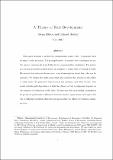| dc.contributor.author | Ellison, Glenn | |
| dc.contributor.author | Holden, Richard | |
| dc.date.accessioned | 2015-04-23T20:11:53Z | |
| dc.date.available | 2015-04-23T20:11:53Z | |
| dc.date.issued | 2013-11 | |
| dc.identifier.issn | 8756-6222 | |
| dc.identifier.issn | 1465-7341 | |
| dc.identifier.uri | http://hdl.handle.net/1721.1/96770 | |
| dc.description.abstract | This article develops a model with endogenously coarse rules. A principal hires an agent to take an action. The principal knows the optimal state-contingent action, but cannot communicate it perfectly due to communication constraints. The principal can use previously realized states as examples to define rules of varying breadth. We analyze how rules are chosen under several assumptions about how rules can be amended. We explore the inefficiencies that arise and how they depend on the ability to refine rules, the principal’s time horizon and patience, and other factors. Our model exhibits path dependence in that the efficacy of rule development depends on the sequence of realizations of the state. We interpret this as providing a foundation for persistent performance differences between similar organizations and explore the role of different delegation structures in ameliorating the effects of bounded communication. | en_US |
| dc.description.sponsorship | Sloan School of Management (Program on Innovation in Markets and Organizations) | en_US |
| dc.description.sponsorship | National Science Foundation (U.S.) (SES-0550897) | en_US |
| dc.language.iso | en_US | |
| dc.publisher | Oxford University Press | en_US |
| dc.relation.isversionof | http://dx.doi.org/10.1093/jleo/ewt016 | en_US |
| dc.rights | Creative Commons Attribution-Noncommercial-Share Alike | en_US |
| dc.rights.uri | http://creativecommons.org/licenses/by-nc-sa/4.0/ | en_US |
| dc.source | Ellison via Kate McNeill | en_US |
| dc.title | A Theory of Rule Development | en_US |
| dc.type | Article | en_US |
| dc.identifier.citation | Ellison, G., and R. Holden. “A Theory of Rule Development.” Journal of Law, Economics, and Organization 30, no. 4 (November 25, 2013): 649–682. | en_US |
| dc.contributor.department | Massachusetts Institute of Technology. Department of Economics | en_US |
| dc.contributor.approver | Ellison, Glenn | en_US |
| dc.contributor.mitauthor | Ellison, Glenn | en_US |
| dc.relation.journal | Journal of Law, Economics, and Organization | en_US |
| dc.eprint.version | Author's final manuscript | en_US |
| dc.type.uri | http://purl.org/eprint/type/JournalArticle | en_US |
| eprint.status | http://purl.org/eprint/status/PeerReviewed | en_US |
| dspace.orderedauthors | Ellison, G.; Holden, R. | en_US |
| dc.identifier.orcid | https://orcid.org/0000-0003-3164-0855 | |
| mit.license | OPEN_ACCESS_POLICY | en_US |
| mit.metadata.status | Complete | |
